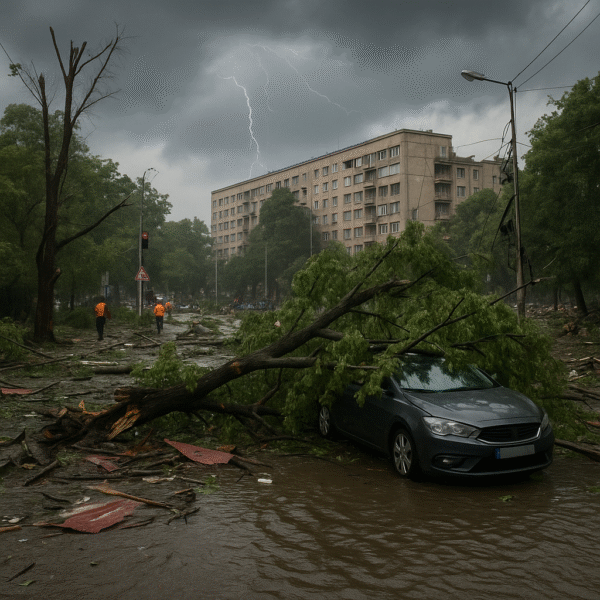Romania is grappling with the aftermath of a devastating storm that swept across the country between July 17 and 18, causing destruction in over 60 localities, with Bucharest and 14 counties bearing the brunt of the severe weather. High winds, lightning, flash flooding, and structural damage have left communities reeling, prompting large-scale emergency response efforts and a national conversation about disaster preparedness.
Confirmed Fatality and Injuries in Ilfov County
The most tragic outcome of the storm occurred in Otopeni, Ilfov County, where a 49-year-old woman died after being struck by roofing debris torn from a nearby building during the storm. Two other individuals in Bucharest sustained injuries from falling trees and branches, though both were reported conscious upon medical arrival and received hospital care.
These incidents have brought renewed focus to the vulnerability of urban areas during high-intensity weather events and highlight the importance of rapid emergency response.
Counties Under Code Red and Orange Weather Alerts
The Department for Emergency Situations (DSU) declared Code Red and Code Orange alerts across multiple counties: Bucharest, Ilfov, Giurgiu, Constanța, Tulcea, Buzău, Argeș, and others. These are among the highest-level alerts in Romania’s emergency classification system and signal life-threatening weather conditions.
Authorities activated Ro-Alert emergency notifications across the affected regions, urging residents to take shelter and avoid unnecessary travel. The storm left a trail of destruction across Argeș, Bacău, Brașov, Buzău, Constanța, Dâmbovița, Galați, Giurgiu, Ialomița, Ilfov, Mureș, Prahova, Teleorman, Vrancea, and the capital.
Emergency Crews Face Enormous Cleanup Operation
Between 7:00 a.m. July 17 and 7:00 a.m. July 18, emergency response teams worked around the clock to mitigate widespread damage. According to official DSU updates:
- 555 trees and 24 power poles were cleared from roads.
- 83 rooftops, including those of two public institutions, were severely damaged.
- 186 vehicles were hit by fallen debris, trees, and construction materials.
- Water was pumped from 3 homes, 49 yards, 11 basements, and a flooded city street in Bucharest.
These statistics illustrate the storm’s vast reach and the massive effort required for cleanup and recovery. Local governments and volunteers have mobilized to assist with damage assessments and rebuilding.
Transport Disruption Hits Roads and Airports
Severe weather conditions disrupted traffic throughout the country. The A1 motorway in Giurgiu County was temporarily closed due to downed road signs and branches, causing delays for drivers and cargo haulers.
In Bucharest, Henri Coandă International Airport (OTP) saw major disruptions. Approximately 15 incoming flights were forced into holding patterns due to storm turbulence, creating delays and congestion. While airport personnel worked swiftly to restore operations, travelers endured significant wait times, both in the air and at terminals.
These transportation challenges revealed vulnerabilities in Romania’s weather-response systems and raised calls for stronger contingency planning at critical infrastructure points.
Government Responds with Relief and Restoration Plans
Romania’s national and regional authorities have pledged immediate recovery assistance to affected communities. Efforts are underway to restore electricity and water in rural and urban zones still without service. Local disaster management teams are compiling damage reports and coordinating with the central government for financial aid and reconstruction materials.
The Romanian Ministry of Internal Affairs has emphasized the importance of community solidarity during this crisis, highlighting the vital role of civil defense volunteers and local firefighters in keeping damage and injury levels from escalating further.
Agricultural Concerns and a Sobering Loss
The storm also delivered a blow to Romania’s agriculture sector, which had already been suffering from unseasonable climate variability. The strong winds and rain likely damaged standing crops and soil structure across affected rural counties—a concern that the Ministry of Agriculture will evaluate in coming days.
In an unfortunate and unrelated event during the same period, the Minister of Agriculture, Florin Mircea, passed away. His sudden death comes as the country faces significant agricultural and environmental challenges. His loss is being widely mourned, and officials are calling for greater resilience in both policy and infrastructure to meet future climate shocks.
National Dialogue on Preparedness and Resilience
The storm’s devastation has intensified public discourse on climate change, infrastructure readiness, and emergency communication systems. Romania has experienced increasingly frequent and extreme weather patterns over the past decade, prompting experts to call for expanded national weather monitoring and storm-proof infrastructure investments.
Environmental groups and civic planners have also urged authorities to adopt green urban planning strategies, including better tree management in cityscapes, modern drainage systems, and enhanced disaster awareness education.
Conclusion: Recovery and Future Preparedness in Focus
As communities in Bucharest and 14 counties begin the process of recovery, Romania is grappling with both the short-term damage and long-term implications of this natural disaster. With fatalities confirmed, property damaged, and infrastructure disrupted, the importance of national preparedness and climate resilience has never been clearer.
Authorities continue to coordinate disaster relief while experts evaluate ways to mitigate the impacts of future extreme weather events. For the Romanian people, the recent storm is a painful but powerful reminder of the urgency to act in the face of a changing climate.
Let me know if you’d like an image to accompany this article or a social media preview card with real-time storm alerts and travel safety tips.
For more travel news like this, keep reading Global Travel Wire
















